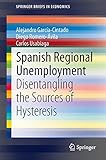Spanish Regional Unemployment [electronic resource] : Disentangling the Sources of Hysteresis / by Alejandro Garc�ia-Cintado, Diego Romero-�Avila, Carlos Usabiaga.
By: Garc�ia-Cintado, Alejandro [author.].
Contributor(s): Romero-�Avila, Diego [author.] | Usabiaga, Carlos [author.] | SpringerLink (Online service).
Material type: BookSeries: SpringerBriefs in Economics: Publisher: Cham : Springer International Publishing : Imprint: Springer, 2014Description: IX, 68 p. 3 illus. online resource.Content type: text Media type: computer Carrier type: online resourceISBN: 9783319036861.Subject(s): Macroeconomics | Economic policy | Labor economics | Regional economics | Spatial economics | Economics | Labor Economics | Macroeconomics/Monetary Economics//Financial Economics | Economic Policy | Regional/Spatial ScienceAdditional physical formats: Printed edition:: No titleDDC classification: 331 Online resources: Click here to access online
BookSeries: SpringerBriefs in Economics: Publisher: Cham : Springer International Publishing : Imprint: Springer, 2014Description: IX, 68 p. 3 illus. online resource.Content type: text Media type: computer Carrier type: online resourceISBN: 9783319036861.Subject(s): Macroeconomics | Economic policy | Labor economics | Regional economics | Spatial economics | Economics | Labor Economics | Macroeconomics/Monetary Economics//Financial Economics | Economic Policy | Regional/Spatial ScienceAdditional physical formats: Printed edition:: No titleDDC classification: 331 Online resources: Click here to access online Introduction -- PANIC Analysis of Spanish Regional Unemployment -- Explaining the Common Stochastic Trend in Spanish Regional Unemployment: Granger-Causality Analysis -- Policy Considerations Drawn from Our Results -- Concluding Remarks -- Appendix.
This work investigates the time series properties of the unemployment rate of the Spanish regions over the period 1976-2011. For that purpose, the authors employ the PANIC procedures of Bai and Ng (2004), which allows to decompose the observed unemployment rate series into common factor and idiosyncratic components. This enables the authors to identify the exact source behind the hysteretic behaviour found in Spanish regional unemployment. Overall, the analysis with three different proxies for the excess of labour supply renders strong support for the hysteresis hypothesis, which appears to be caused by a common stochastic trend driving all the regional unemployment series. In the second part of the analysis the authors try to determine the macroeconomic and institutional factors that are able to explain the time series evolution of the common factor, and in turn help us shed light on the ultimate sources of hysteresis. The reader shall see how the variables that the empirical analysis emphasises as relevant closely fit into the main causes of the Spanish unemployment behaviour. Finally, some policy considerations drawn from the results are presented.


There are no comments for this item.